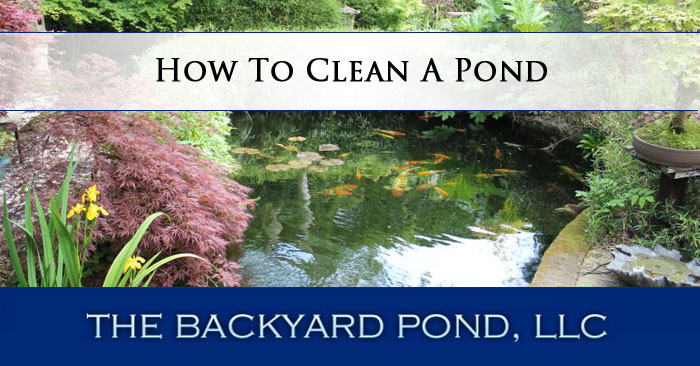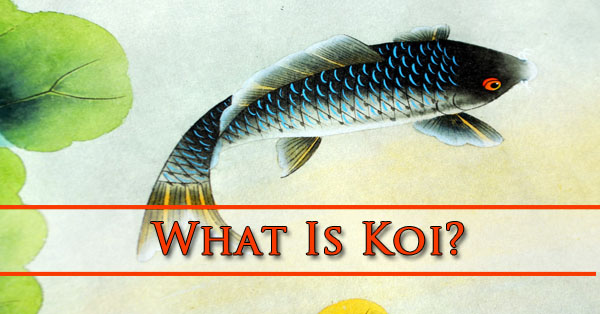
If you are searching for “how to clean a pond“, this post by The Backyard Pond can help! It doesn’t matter how hard you try, you will have to clean your pond at some point. Cleaning your pond can greatly increase the lifetime of your pond (and your Koi fish, if you have them) and let you enjoy it for years to come.
Cleaning Your Pond
There will come a time that you will need to clean your pond. You may be preparing your pond for the summer or winter, or maybe you been a little lax on the upkeep and maintenance. There are steps you can take to clean your pond and make it look “newish”. A clean pond gives a new environment for the bacteria in your biological filter and fresh water for the fish. The amount of cleaning required will usually depend on the size of your pond and location of it.
Remove Your Koi Fish From Your Pond
This is far from a clean job, so you shouldn’t wear your Sunday best. Take into account you’re going get dirty, the smell may be unbearable and it might be a bit cold. You’re going to need a fine mesh aquarium net, a garden hose with a spray adapter, and a holding tank (if you plan on removing your fish) big enough to store your fish while cleaning out your pond. You also may need to use a pond vacuum, pond cleaning gloves, if you have access to them.
If your pond is a smaller one, you can simply scoop your Koi out with the aquarium net to transfer them into the holding tank. If you have a larger Koi pond, it might be simpler to just let the fish be. If you do plan on removing them, fill the holding tank with pond water from you pond so an abrupt change in water temperature or water quality won’t shock your fish.
Get Rid Of Surface Debris
More often than not you’re going to see an assortment of sticks and leaves floating on the surface of the pond. Use the net to scoop out all of the debris. This is an easy part but don’t think this is it, you’re far from done. You’re going to get messy soon enough.
Drain The Koi Pond
Use a pond pump to drain the water out of the pond. If you leave your fish in the pond, you clearly don’t want to pump out all of the pond water.
Draining will expose the sides of the pond and makes it a lot easier to remove the algae and other gunk. Depending on the type and strength of your pond pump and the size of your pond, it could take a couple of minutes or in some cases longer than an hour.
Make sure to send the pond water to an area in your yard that has really good drainage. Also try and take at least an hour-long break after you drain the pond and let the sun to dry out the newly revealed algae.
Remove Any Pond Plants and Any Accessories
Remove the pond pump, pond plants and anything else that can be removed. Remove any water lilies and other pond plants in autumn, if you still have plants in your pond at the beginning of spring, take them out too. Use the garden hose and an old toothbrush to really clean all the accessories and their hard to reach places. This is an ideal time to clean or replace the filter on your pond pump. Some pumps have a mesh bag, I yours does simply spray it off with your hose.
Clean the Pump
Now is a great time to clean out your pond’s pump. There are various different types of algae that can thrive in your ponds’ ecosystem. While some of it is valuable for the pond and a natural part of its ecosystem, while string algae is not. You’ll know when you are seeing string algae if it’s stringy, clearly, and if you are capable of just pulling it out of your pond. It tends to stick to bottom of ponds and grow upwards in long strands. They get caught up in your pump and other mechanical systems very easily, and the best and easiest way to clean it is to take the pump out and physically clear away the algae. You can use a brush to scrub any growth on the outside of the casing, but if any sting algae has gotten inside, you will need to take out the pump from the pond altogether.
Get In There And Clean Your Backyard Pond
Use a hose with a spray attachment and forcefully spray away the algae growth on the sides of the Koi pond. Be sure to spray the waterfall and the rocks that line the outside of the pond.
Then, use the net to scoop out the muck and sludge that’s been sitting at the bottom of the pond. This is going to be the messy part. You’re likely to come across a lot of smelly slime, partially decayed plant material and maybe even an incidental lizard or fish.
Once you are done cleaning the pond, it’s time to put the pond back together. Connect the pond pump back up, and replace all of your pond plants and accessories.
Fill The Pond Back Up
Use the garden hose to refill the pond to the desired water level you like. Once the pond is full, turn on the pump and let the water to circulate for a couple of minutes. Most likely you’re going to use tap water. Tap water has chlorine in it, so you may have to add a dechlorinator to safeguard the fish.
Add Your Fish
The new, fresh water in your pond is more likely colder than the water in the holding tank, so give your fish a little time to acclimate. To protect your fish you will want to dump some of the water out of the holding tank and replace it with the new pond water, and repeat the process a number of times.
Phoenix, Arizona Koi Pond
If you already have a Koi pond or if you are thinking about installing a pond and would like a little help or advice with budgeting and design considerations, talk to the Phoenix Koi Pond Experts in Peoria, AZ at The Backyard Pond. Call us today at 623-878-6695 and see what we can do for you.
